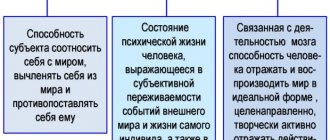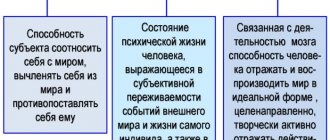Our psyche is a complex structure. Not fully studied, it sometimes gives us not very pleasant surprises in the form of various violations and failures. They disorganize our personality, behavior and emotional state, introducing considerable difficulties into life. Therefore, mental treatment is an important and complex path to restoring our “I”, requiring an integrated and long-term approach.
What is psyche in human psychology?
Psyche in human psychology is one of the active forms of displaying objective reality, which is carried out by a specific subject integrated into society. Perception and processing of information occurs through interaction with environmental objects and highly organized living beings.
A distinctive feature of the presence of a healthy psyche in the psychological component of psychology is the action of the regulatory function, which takes part in the coordination of behavioral activity and compliance with generally accepted rules. In fact, this is the inner world of a person, the formation of which occurs throughout his life.
Scientific interpretation
The psyche in psychology is an individual property of the human body, which consists in the ability to independently perceive the world around us, construct an objective reality, as well as regulate one’s behavior and activities.
From a scientific point of view, the psyche is characterized by the presence of basic qualities in the form of integrity, psycho-emotional activity, desire for development and knowledge of the world around us, self-regulation of one’s actions, communication with other highly organized beings, and the ability to quickly adapt to new conditions.
The independent science of psychology studies the psyche and the processes it covers.
Body or psyche: what comes first?
According to generally accepted scientific theory, such a property of the human body as the psyche appeared at a certain stage of biological evolution.
The body was primary matter, which over the course of several thousand years went through multiple stages of its improvement and adaptation to new conditions of a constantly changing environment. As the brain grew and developed, the human central nervous system acquired new functionality.
Highly organized organisms have the opportunity to perceive the world more broadly, comprehend the information received, establish new communication connections, create their own picture of objective reality, and also make independent decisions in the current situation.
The emergence of the psyche played an important role in the further development of mankind. From a religious point of view, people were originally created with developed brain centers responsible for the presence of the psychic aspect and consciousness.
People with mental disorders
As already mentioned, every person is susceptible to mental illness to varying degrees. Unfortunately, a healthy lifestyle and careful treatment of the nervous system cannot always guarantee the effect of “vaccination” against such diseases. People with mental disorders are not always the ones you often see in films. Not everyone wears white straitjackets, hears voices and sees things that others don't. Most people suffering from mental disorders are ordinary passersby whom you can meet on the way to work, neighbors at the nearest table in a coffee shop, and even friends and family. However, there are also more serious forms of the disease.
Properties of the psyche
Mental properties are a set of individual psychological characteristics inherent in an individual person, which determine his already formed methods of communication with environmental objects. This aspect includes interactions with inanimate objects as well as other people.
Mental properties are individually expressed qualities that are considered unchanged in the conditions of temporary space. At the same time, they can undergo radical changes under the influence of life experience, a number of biological factors, and the type of activity of a particular person.
The table below lists and also describes in detail the main properties of the psyche, the presence of which is characteristic of each person.
| Properties of the psyche | Description |
| Temperament | This property of the psyche is characterized by a direct influence on the mental and psycho-emotional qualities of a person. There are 4 main types of temperament, including melancholic, sanguine, phlegmatic and choleric. This mental property indicates the degree of excitability of the individual, the level of his vital energy and the ability to quickly make decisions. In most cases, a person’s particular type of temperament remains the same throughout his life, but can also change under the influence of biological factors. For example, an imbalance of sex hormones, the occurrence of mental disorders and diseases of internal organs that affect the psycho-emotional component of behavior. |
| Character | This property of the psyche is distinguished by the structure of constant and persistent qualities of a particular person, which influence her attitude to the world around her, people, and also determine her behavioral norms. The formation of character is influenced by the conditions in which a person grew up and was brought up, the hereditary component, and environmental factors. Temperament and character are closely related |
| Individual abilities | This property of the psyche consists in a person’s ability to implement his acquired skills in the processes of performing a certain type of activity. Individual abilities of a person develop throughout her life, but subject to training and the initial presence of appropriate inclinations. |
Mental properties are the personal qualities of people that are subject to mandatory study when drawing up a psychological portrait. Character, temperament and individual abilities are interconnected and also form the individual characteristics of each person.
Mental disorders in children
As every child goes through certain stages of his life, he faces a lot of problems and challenges. Some people endure all the difficult periods, but there are also those who are not ready for such conditions. Mental disorders in children can begin under the pressure of various factors.
- The formation process is often accompanied by the child’s rejection of himself and his own body. This causes various behavioral reactions, such as overeating or, conversely, refusing to eat. This eating disorder can lead to anorexia or bulimia.
- Peer bullying. Once one person stands out, he becomes a target for others. School bullying causes nervousness, psychosis, and depression. Suicidal thoughts may appear.
- Tense situation in the family. A very common cause of mental disorders in children is an unhealthy environment. If constant violence occurs in front of a child, then a mental disorder is guaranteed and can subsequently cause the development of schizophrenia. In an attempt to escape from reality, children invent a different life for themselves and stop this process, especially in an advanced stage. It can be extremely difficult.
- Congenital mental disorders of children can be caused by genetic predisposition, as well as unacceptable behavior of parents at the time of bearing the baby.
Functions
Psyche in psychology is an independent branch of knowledge that studies the inner world of a person, his actions and attitude towards his actions.
Famous Soviet scientists Golikov Yu.Ya., as well as Kostin A.N., identified 3 main functions of the human psyche. These are cognitive, reflective and regulatory abilities.
Reflectivity
The reflective function of the psyche is to build an individual way of interacting with the outside world.
An adult with a healthy psyche has the ability to build communications with other people, studies objects in his environment, comprehends the information received, and then develops for himself a set of norms and rules that guide him in the process of daily life.
The reflective ability of the psyche plays a key role during the period of human adaptation to new conditions of the surrounding world. For example, changing jobs, meeting a lot of people, moving to a permanent place of residence in another city. The reflective function allows you to successfully overcome stressful situations, as well as cope with their consequences.
Regulatory Capacity
The regulatory function of the psyche includes a person’s ability to organize his activities, control over his psycho-emotional state, and compliance with behavioral rules and norms that are characteristic of a particular social group or society.
Under the influence of regulatory ability, a person develops his own attitude to the conditions of objective reality that surrounds him.
According to its content, the regulatory function of the human psyche can be divided into an emotional and meaningful component.
In the first case, we are talking about psycho-emotional reactions present in the behavior of a particular individual. The meaningful component of the regulatory function involves thinking about one’s actions and actions before committing them, during active activity or after its completion.
Cognitive ability
The cognitive function of the psyche is a person’s ability to think and plan complex tasks, the implementation of which requires the use of environmental objects, acquiring new acquaintances, establishing communications, and observing the rules of sequence and phasing of actions.
Cognitive ability develops only in the process of daily learning, obtaining new information from environmental conditions.
This mental function is closely related to the intellectual stage of personal development. Some people have high, and others lower, genetic inclinations for cognitive abilities, but all of them, without exception, require their additional development.
Without this mental function, a person cannot be guided by common sense, perform actions and make decisions that comply with generally accepted rules and norms.
Family and group psychotherapy
Group therapy involves forming a group of people under the supervision of a psychotherapist.
The group members communicate with each other about the most secret things that they did not dare to tell anyone before. Participants in the conversation talk about their problems, feelings and experiences. By opening up to others, they get to know themselves, their world, and look for solutions to their problems. The basis of successful group therapy is sincerity in statements. Family therapy is based on the opinion that the family is an integral structure that lives according to its own laws. The relationships between its members play a special role in the dynamics of the mental disorder of one of them.
Family psychotherapy allows you to analyze relationships in the family and find out what exactly leaves a negative imprint on the patient, and forces him to turn on compensatory mechanisms in order to survive conflict in the family.
It has been established that the most common problem in family relationships is spouses copying the behavior patterns of their parents. They transfer to their spouse and children the same actions that were carried out by their mothers or fathers. That is, it is a kind of transfer. And the marriage partner or child is perceived in a special, mostly unflattering light (capricious, demanding, tyrant, etc.). Because of this, difficulties then appear in family relationships, leaving a destructive imprint on the psyche of one of its members.
Along with psychotherapy, patients with mental disorders in remission are subjected to social rehabilitation. It gives them the opportunity to develop basic behavioral skills. For example, taking care of your appearance, cleaning the apartment, going to the store, traveling on public transport, as well as gaining knowledge that will help patients finish school or get a profession.
Structure of the psyche
The psyche in psychology is a complex and holistic structure, the basic elements of which are described in the table below.
| Constituent components of mental structure | Characteristics of individual elements of the structure of the psyche |
| Mental process | This is one of the most dynamic components that is present in the psyche of any person. Mental processes arise and develop during the interaction of a person with objects in the environment, communication with other people, studying and collecting new information. A distinctive feature of this component of the psyche is that mental processes are continuous. They continue even while the person is sleeping. Impulses of nerve endings, the influence of external and internal factors, the emergence of new needs, all these are components of mental processes of various directions. |
| Mental neoplasm | This is a separate structural element of the psyche, which includes the skills, knowledge and new abilities acquired by people. Mental neoplasms are the result of prolonged work, training, and life experience of an individual. The mass fraction of this structural element of the psyche depends on each person individually. People employed in production, working with complex equipment and software, constantly update their mental formations, acquiring additional knowledge. |
| Mental condition | This is part of the general structure of the psyche, which is characterized by the presence of a general psycho-emotional state of a person. It can be cheerfulness, fatigue, joy, anger and outbursts of rage, anger, regret, fatigue. Various mental states of an individual do not arise by chance, but are created by the influence of a combination of factors that are important for a particular person. For example, health status, success in business and at work, loss of a loved one, encouragement or punishment for an action. The general mental state is divided into pessimism and optimism. |
The full development of all structural elements of the psyche allows a person to receive further education, acquire new skills and abilities, establish social connections, and also live in accordance with generally accepted norms of behavior.
Lecture on the topic "Psyche and body." Biological foundations of the psyche"
Topic No. 2. Psyche and body. Biological foundations of the psyche.
Lecture 2
1. Specificity of the laws of the psyche.
2. Reflex principles
3. Brain functions. Consciousness and unconsciousness
- Specificity of the laws of the psyche.
Psyche is a general concept that unites many subjective phenomena studied by psychology as a science. In accordance with the idealistic understanding of the psyche, not one, but two principles are distinguished in the world: material and ideal. They are independent, eternal, not reducible and not deducible from each other. While interacting in development, they nevertheless develop according to their own laws. In the ideas of materialists, psychic phenomena arose much later than life appeared on Earth. At first, a living creature had only the biological properties of irritability and self-preservation, manifested through the mechanisms of metabolism with the environment, its own growth and reproduction. Later, at the level of more complexly organized living beings, sensitivity and readiness to learn were added to them. In this regard, a special organ emerged - the nervous system, which took on the function of controlling development, behavior and reproduction.
Improving the structure and function of the nervous system served as the main source of mental development. The mechanism of this process is apparently the same with the help of which the evolution of living beings is described and presented: the acquisition by an organism of new properties and organs as a result of changes occurring in the genotype; adaptation to the environment and survival of those creatures whose properties and organs turned out to be the most useful from the point of view of life support, survival and adaptation.
At the same time, there are many facts that definitely indicate a relationship that exists between brain and psychological processes, material and ideal states.
Consciousness is a structure and this structure consists of elements organized in a certain way.
Properties of consciousness
1) Limitation (it accommodates a limited number of simple impressions). Measuring the volume of consciousness - volume of attention -7+-2 elements, volume of consciousness - 16-40 elements.
2) Heterogeneity: two areas: the area of vague consciousness and clear consciousness and the point of fixation, which is located in the center of the area of clear consciousness (this is the area of the brightest consciousness). This is the field of attention and the periphery.
3) Rhythm. Individual elements of consciousness tend to form groups of elements that are interconnected. This might be involuntarily or controlled by attention. Due to grouping, the volume of attention and consciousness can increase.
Basic processes of consciousness.
- Perception is the process of any content entering the field of consciousness.
- Apperception (associated with the area of clear vision) - concentration of consciousness (attention) on any content, i.e. the content falls into the realm of clear consciousness. The organization of a higher order unit is an act of apperception (letters into words, words into phrases, etc., i.e., the unification of small units of consciousness into large ones).
3 goals of the Wundt program:
- The division of consciousness into elements that cannot be further divided.
- Find out what relationships these elements have.
- On this basis, formulate the general laws of mental life.
1. Elements of consciousness:
- Objective (coming from the outside, from an object) - simple impressions, sensations and ideas. They have properties: quality, intensity, (Titchener also added extension in time, extension in space).
- Subjective (related to the subject, his internal experiences) – feelings, emotions. 3 parameters: pleasure-displeasure; excitement-calming; voltage-discharge. More complex feelings are made up of these elements. Feelings provide a connection between elements, a synthesis of elements of consciousness.
2. Laws of connection between these elements.
1) The principle of gradation of elements (simple feelings in more complex formations)
2) The principle of integrity (a whole feeling is perceived as a single whole, indivisible into parts, not a sum, emotional value is added).
Relations: Principle of associations (Hume: by similarity, by contiguity in space and time, causality); (Herbart: merging of similar ideas, assimilation, dissimilation, complication - the combination of individual sensations without loss of quality into some holistic formation.
3. Laws of mental life:
- The law of mental relations - all elements of consciousness are in connection with each other and depend on each other.
- Law of contrast - if these relations are relations of contrast, then they are perceived clearly.
- The law of creative synthesis - complex mental formations cannot be reduced to their parts.
- Heterogony (heterogeneity) of goals - an intermediate goal can acquire the status of a main one.
In some areas of psychology (physiological psychology), Wundt's theory still works.
The history of Gestalt psychology begins with the publication of the work of M. Wertheimer “Experimental studies of the perception of movement” (1912).
The reason for their dissatisfaction was that higher mental processes remained outside of precise experimental analysis, which was limited to sensory elements and the principle of associations.
1. Basic concepts:
Gestalt is a holistic structure that has a special quality compared to the sum of its parts. A specific feature of Gestalt is the property of transposition (transfer). Experiment - 2 points at a certain distance from each other are lit alternately with different intervals of 200, 30 and 50 ms. At a certain time interval (50 ms), an apparent movement, a stroboscopic effect, and a phi phenomenon occurs. Movement as a special quality cannot be reduced to the sum of two points.
Insight is a holistic understanding of the situation - such a holistic organization of a problem situation that allows you to resolve the problem and eliminate the conflict contained in it. Insight in thinking (understanding) - gestalt in perception.
Research covered perception, thinking, memory, affects, and will.
Method - phenomenological method - direct description by the observer of the content of his perception, his experience (description of objective perception as they see it at the moment). Allows you to describe not only subjective phenomena, but also externally observable behavior (experiments on animals). There is no difference between description and explanation (description is explanation).
2. Basic principles:
The principle of isomorphism (an expression of the structural unity of the world: physical, physiological and psychological: the mental world is an exact structural reproduction of the dynamic organization of the corresponding brain processes).
The principle of structure (a whole that determines the properties and meaning of its parts is called structure): an element does not have a meaning, but receives it in a certain structure in which it is included.
3. Studies of visual perception.
The whole is primary in perception. Sensation is not an element; the unit is considered to be a visual image, a figure against a background. Elements of the visual field are combined into a structure depending on a number of factors (proximity of elements to each other, similarity of elements, closedness, symmetry, etc.).
A holistic image is a dynamic structure that is formed according to the special laws of the organization. In the visual field during perception, binding and restraining perceptual forces act.
Figure and background properties:
- the figure appears more intense than the background
- the outline is perceived as belonging to the figure
- the figure appears phenomenally closer (and larger) than the background, and the background extends continuously behind the figure.
Laws of perception:
- Law of figure and ground (Rubin) (the figure is a stronger and more stable structure than the background);
- The law of pregnancy (the tendency of the perceptual organization towards internal orderliness, leading in a situation of an ambiguous stimulus configuration to a “good figure”, to simplifying perception;
- The law of addition to the whole (“amplification”, if the figure is not complete, in perception we strive to see it as a whole).
This phenomenology was explained using the principle of isomorphism. The structures are a direct reflection in consciousness of a physiological process in the brain that arises as a result of external influences that reach the cortical fields in the form of afferent impulses. Physiological patterns were explained by the physical laws of the electromagnetic field.
Behaviorism - “the science of behavior” arose in the USA (1913) as opposed to the psychology of consciousness.
The transition to a new subject in psychology occurred for the following reasons:
- Common sense considerations (the psychologist must deal with behavior)
- Practice requests
- The desire to build psychology as a natural science discipline, to introduce an objective scientific method.
The founder of behaviorism, J. Watson: “psychology as a science of consciousness is fundamentally impossible.” She is biased:
- In natural sciences, the subject and object of cognition are separated; the fact of observation does not change the result of the experiment; in introspection, the very fact of observation changes the course of mental processes).
- Observer subjectivity. It is impossible to repeat the experiment with the same results.
Psychology as a science of behavior - all external manifestations of humans and animals - is free from these shortcomings.
The subject of behaviorism is the study of behavior in an objective way; the purpose is to serve the practice.
The philosophical basis of behaviorism is positivism and pragmatism.
The practical task of behaviorism is the purposeful change of human behavior.
Scientific background: Thorndike's studies of animal psychology, objective psychology, works of Pavlov and Bekhterev.
- Classic behaviorism
All forms of behavior can be represented in the form of complex complexes consisting of elementary and indecomposable simple behavioral acts - reactions, interconnected by laws.
The main problems (tasks) of classical behaviorism:
- Study of behavior. Establishing connections between stimulus and response;
- Behavior control (modeling such stimuli that allow you to get a certain reaction)
A response is a behavioral change caused by an external stimulus. S - R - unit of behavior. The stimulus is a physical impact, the response is an elementary (unconditioned, reflex) motor reaction. If we understand a stimulus situation as a stimulus, then the response will be a certain way of behavior. Watson believed that a person is born with a certain set of innate reactions from which all elements of behavior subsequently develop. Congenital reactions: sneezing, hiccups, sucking, smiling, crying, movements of the torso, limbs, head. Acquired reactions are formed from elementary ones through conditioning.
Classification of reactions:
- Acquired - hereditary,
- internal (hidden) - external (external).
External acquired - playing tennis, opening a door;
External hereditary - grasping, sneezing, instincts and emotions;
Internal acquired – thinking;
Internal hereditary - reactions of the endocrine glands, changes in blood circulation.
Instinct is an adaptation caused by external stimuli.
Emotions are adaptations caused by internal stimuli and relate to the subject’s body (for example, blushing).
In practice, behavior is the result of learning. Hence skill and learning are the main problems of behaviorism. Speech and thinking are considered as types of skills.
A skill is an individually acquired or learned action. Its basis is elementary movements that are innate. A new element in a skill is the tying together or combining of separate movements in such a way as to produce a new activity.
- Reflex principles
Late 18th century - the development of natural science - a strictly causal worldview became stronger. An attempt to move to new empirical methods. The generation of a new object and subject. The doctrine of the psyche is separated from the doctrine of the soul. It was necessary to identify a criterion for distinguishing mental from non-mental. Such a criterion was awareness (identification of the psyche and consciousness) - Descartes
.
Consciousness (spirit) is the world of spirituality, thinking (feelings, motivations....). It is a spiritual substance that is primordial; The spiritual and material worlds exist initially and interact with other worlds. through the pineal gland. The soul does not arise from the material world, and matter from the spirit. The psyche is a special world, qualitatively different from everything around it. There are two types of our existence: real life and knowledge. In life, determination to act (act as decided). In knowledge there is a method of doubt (the goal of consciousness is the pursuit of truth). Doubt is the act of thinking => thinking is known to us before and more reliably than any bodily thing. Thinking is everything that happens in us consciously. Thus, Descartes found reliable knowledge of the soul in the direct experience of mental processes. Descartes chooses a new method of research: he refuses an objective description and turns to considering only his thoughts, i.e. subjective states. Strict division of soul and body. The body turns into a machine that interacts with the soul. Animals do not have a psyche. Babies don't have it. God brings the soul into the body of a child. Animals are reflex machines. It was Descartes who first introduced the concept of reflex. Locke
proposed a method for studying consciousness. Two types of experience: objects of sensation and internal perception of the actions of our mind (thinking and considering these actions - reflection). He introduced the concept of reflection - the receipt of ideas that are acquired by the mind through reflection on one’s own activities. The mind can simultaneously engage in acquired ideas and reflect on this activity => a method of studying mental activity itself - the method of “internal perception”, “introspection”.
3. Brain functions.
In order for a person’s behavior to be successful, it is necessary that his internal state, the external conditions in which the person finds himself. At the physiological level, the function of combining all this is provided by the nervous system. It is anatomically located and designed so as to have direct access and access to the internal organs, to the external environment, to connect them, to control the organs of movement. The human nervous system consists of two sections: central and peripheral. The central one includes the brain, diencephalon and spinal cord. The rest of the nervous system is classified as peripheral.
Thanks to the work of the brain , a person can think, feel, hear, see, touch, and move. The large (terminal) brain controls all vital processes occurring in the human body, and is also the “receptacle” of all our intellectual abilities. What distinguishes humans from the animal world is, first of all, developed speech and the ability for abstract thinking, i.e. the ability to think in moral or logical categories. Only in human consciousness can various ideas arise, for example, political, philosophical, theological, artistic, technical, creative. In addition, the brain regulates and coordinates the work of all human muscles (both those that a person can control through willpower and those that do not depend on a person’s will, for example, the heart muscle). The muscles receive a series of impulses from the central nervous system, to which the muscles respond by contracting with a certain strength and duration. Impulses enter the brain from various sense organs, causing the necessary reactions, for example, turning the head in the direction from which the noise is heard.
The left hemisphere of the brain controls the right half of the body, and the right hemisphere controls the left. The two hemispheres complement each other.
The brain resembles a walnut; it has three large sections - the brainstem, the subcortical section and the cerebral cortex. The total surface of the cerebral cortex increases due to numerous grooves that divide the entire surface of the hemisphere into convex convolutions and lobes. Three main sulci - central, lateral and parieto-occipital - divide each hemisphere into four lobes: frontal, parietal, occipital and temporal. Individual areas of the cerebral cortex have different functional significance. The cerebral cortex receives impulses from receptor formations. Each peripheral receptor apparatus in the cortex corresponds to an area called the cortical nucleus of the analyzer. An analyzer is an anatomical and physiological formation that provides perception and analysis of information about phenomena occurring in the environment and (or) inside the human body, and generates sensations specific to a particular analyzer (for example, pain, visual, auditory analyzer). The areas of the cortex where the cortical nuclei of the analyzers are located are called the sensory areas of the cerebral cortex. The motor zone of the cerebral cortex interacts with sensory zones; when it is irritated, movement occurs. This can be shown with a simple example: when a candle flame approaches, the pain and heat receptors of the fingers begin to send signals, then the neurons of the corresponding analyzer identify these signals as pain caused by a burn, and the muscles are “given the order” to withdraw the hand.
Association zones are functional areas of the cerebral cortex. They connect incoming sensory information with previously received and stored in memory, and also compare information received from different receptors. Sensory signals are comprehended, interpreted and, if necessary, transmitted to the associated motor area. Thus, associative zones are involved in the processes of thinking, remembering and learning.
Telencephalon lobes
The telencephalon is divided into frontal, occipital, temporal and parietal lobes. The frontal lobe contains areas of intelligence, concentration, and motor areas; in the temporal - auditory zones; in the parietal - zones of taste, touch, spatial orientation; and in the occipital region there are visual zones.
Speech zone
Extensive damage to the left temporal lobe, for example as a result of serious head injuries and various diseases, as well as after a stroke, is usually accompanied by sensory and motor speech disorders.
The telencephalon is the youngest and most developed part of the brain, which determines a person’s ability to think, feel, speak, analyze, and also controls all processes occurring in the body. The functions of other parts of the brain primarily include control and transmission of impulses. Certain parts of the brain provide many vital functions - they regulate hormone metabolism, metabolism, reflexes, etc.
for the normal functioning of the brain . For example, if cerebral circulation is disrupted during cardiac arrest or injury to the carotid artery, then after a few seconds the person loses consciousness, and after 2 minutes. Brain cells begin to die.
Functions of the diencephalon
The thalamus and hypothalamus are parts of the diencephalon. Impulses from all receptors in the body enter the nuclei of the thalamus. The received information is processed in the thalamus and sent to the cerebral hemispheres. The thalamus connects to the cerebellum, etc. limbic system. The hypothalamus regulates the autonomic functions of the body. The influence of the hypothalamus is carried out through the nervous system and endocrine glands. The hypothalamus is also involved in the regulation of the functions of many endocrine glands and metabolism, as well as in the regulation of body temperature and the activity of the cardiovascular and digestive systems.
Limbic system
The limbic system plays an important role in the formation of human emotional behavior . The limbic system includes nerve formations of the brain located on the medial side of the telencephalon, near the upper brain stem. This part of the brain is not yet fully understood. It is assumed that the limbic system and the subthalamus controlled by it are responsible for many of our feelings and desires, for example, under their influence thirst and hunger, fear, aggressiveness, and sexual desire arise.
Brain stem functions
The brain stem is a phylogenetically ancient part of the brain, consisting of the midbrain, hindbrain and medulla oblongata. The midbrain contains the primary visual and auditory centers. With their participation, orienting reflexes to light and sound are carried out. The medulla oblongata contains centers for the regulation of respiration, cardiovascular activity, functions of the digestive organs, and metabolism. The medulla oblongata takes part in the implementation of such reflex acts as chewing, sucking, sneezing, swallowing, vomiting.
Functions of the cerebellum
The cerebellum controls body movements. The cerebellum receives impulses from all receptors that are stimulated during body movements. Cerebellar function may be impaired by drinking alcohol or other substances that cause dizziness. Therefore, under the influence of intoxication, people are not able to normally coordinate their movements. In recent years, more and more evidence has emerged that the cerebellum is also important in human cognitive activity.
Cranial nerves
In addition to the spinal cord, twelve cranial nerves are also very important: pairs I and II - the olfactory and optic nerves; III, IV VI pairs - oculomotor nerves; V pair - trigeminal nerve - innervates the masticatory muscles; VII - facial nerve - innervates facial muscles, also contains secretory fibers to the lacrimal and salivary glands; VIII pair - vestibulocochlear nerve - connects the organs of hearing, balance and gravity; Pair IX - glossopharyngeal nerve - innervates the pharynx, its muscles, parotid gland, taste buds of the tongue; X pair - the vagus nerve - is divided into a number of branches that innervate the lungs, heart, intestines, and regulate their functions; Pair XI - accessory nerve - innervates the muscles of the shoulder girdle. As a result of the fusion of the spinal nerves, the XII pair is formed - the hypoglossal nerve - which innervates the muscles of the tongue and the hypoglossal apparatus.
Brain functions include processing sensory information from the senses, planning, decision making, coordination, motor control, positive and negative emotions, attention, memory. The human brain performs the highest function—thinking. One of the most important functions of the human brain is the perception and generation of speech.
Stages of development of the human psyche
The human psyche has 4 main stages of development, at each of which the individual expands the range of his capabilities, receives new information, knowledge, and changes his attitude towards society and the world around him.
Elementary sensory stage
The elementary sensory stage is characterized by the minimum number of skills necessary for survival. At this stage of development, the human psyche was a set of complex behavioral norms, most of which were based on acquired instincts.
Without special training, a person could adapt to various environmental conditions, obtain food for himself, compete for habitat, continue his family, and defend his life in case of danger.
Perceptual stage
The perceptual stage of development of the psyche is no longer based on the instinctive perception of the world and the sensations associated with it. At this stage of evolution, a person acquires new abilities for a more thorough study of environmental objects, collection and analysis of information.
The first signs of individual behavior appear, which directly depends on environmental conditions. The transition to the perceptual stage of mental development is associated with the complication of the structure of the central nervous system and the development of the cerebral cortex. At this stage, a person not only gains life experience, but also gains the ability to self-educate and learn new abilities.
Intellectual stage
The intellectual stage of mental development takes people to a new, more competitive level.
The distinctive features of this stage are that a person is no longer guided by instinctive motives or primary skills, but gains the ability to analyze the current situation, find relationships between certain objects, and look for ways to solve specific problems.
At this stage of mental development, cognitive function is strengthened, memory, learning ability and assimilation of new information improve.
Level of consciousness
The level of consciousness is a special state of mind that is characteristic only of humans. This stage of development allows an individual to have his own subjective opinion, experience events occurring in the world around him, make logical conclusions and form an internal attitude towards what happened.
Consciousness is the highest form of mental reflection of the surrounding reality.
Where to start treatment
If you suspect the development of a mental disorder, the help of a psychiatrist is required. At the appointment, after a thorough examination, the doctor chooses how the patient will receive treatment:
- outpatient;
- in hospital;
- dispensary registration.
According to Article 29 of the Criminal Code of the Russian Federation, a patient can be hospitalized without the consent of him and his relatives in a hospital if his condition causes:
- harming oneself and others;
- inability to perform basic self-service actions;
- deterioration of the condition if the patient is not hospitalized.
Previously, treatment of the mentally ill was not distinguished by humanism and delicacy. For example, in 1936, the Portuguese doctor Egas Moniz proposed a method of lobotomy. That is, the removal of some parts of the brain. After 20 operations performed, he announced the results. seven experimental subjects were completely cured of mental illness, another seven showed noticeable improvements. For the rest, the condition remained at the same level.
Surprisingly, this method has gained great popularity, and its author was even awarded the Nobel Prize in Medicine.
Currently, therapy for the mentally ill is carried out in several directions and has a more gentle approach:
- pharmacotherapy;
- psychotherapy;
- social rehabilitation.
Mental processes
The psyche in psychology is an integral structured system, the elements of which are mental processes. The latter are a group of daily events that are united according to functionality.
The following types of mental processes are distinguished:
- imagination;
- thinking;
- speech activity;
- Feel;
- physiological reflection;
- emotions;
- being under stress;
- affect;
- setting and pursuing a given goal;
- making an independent decision;
- doubts about choice;
- struggle of motives;
- concentration of attention;
- ability to remember information.
Unlike other structural elements of the psyche, the above processes are present in human life every day. The most in demand are mental processes of the cognitive type associated with the thought process, communication with other people, concentration, and the work of the imagination.
Panic disorder
Panic attacks are the main symptom of this type of disorder. These are usually short-term painful attacks of anxiety, worry, and fear. They are accompanied by physiological manifestations - increased heart rate, dizziness, shortness of breath, nausea. The arms and legs go numb, and the person experiences great fear because he cannot control himself at such a moment.
What causes panic attacks? Causes may include stress, alcohol and substance abuse, and exhaustion. A pattern of genetic inheritance of this disorder has also been identified. Having experienced a panic attack one or more times, a person begins to fear that the attack will happen again. Many begin to avoid large crowds of people, some stop leaving the house altogether. Ignoring the symptoms of a panic attack can lead to other mental disorders. Therefore, the best thing in such a situation is to contact a psychotherapist as soon as possible.
Mental states
Mental states are a set of modes of vital activity of the human body, which differ from each other in energy characteristics, emotional component, and physiological activity of internal organs and systems. Changes in mental states are directly related to the influence of external and internal factors.
There are the following mental states characteristic of humans:
- situationally determined, arising as a response to a temporary stimulus (non-acceptance of abuse, bad actions of people around);
- superficial, associated with changeable moods;
- positive, which are caused by a feeling of inspiration, emotions of joy, happiness, love;
- unconscious, which are inherent in people in a state of sleep or trance;
- asthenic, occurring with fatigue, loss of vitality, motivation to act;
- physiological, accompanied by a feeling of hunger and pain.
Depending on the type of mental state, their duration can be short-term, medium-term or long-term. The rate of change in mental states depends on the character and temperament of the individual.
Child psyche
The distinctive features of the child’s psyche are that at different stages of the child’s development its structural components are formed.
The quality and state of health of the child’s psyche directly depends on the conditions in which upbringing takes place, what methods are used, and whether the child receives preschool education, good nutrition and the care of loved ones.
The formation of a child’s psyche occurs through the emergence of internal and social crises, which manifest themselves as they reach a certain age.
Treatment of mental disorders in children
Most mental disorders in children are caused by adolescence and the stage of personality development. If symptoms indicating the development of deviations are detected, it is necessary to stabilize the atmosphere in the family as much as possible, spend more time with the child, talk about topics that concern him and support him in the first uncertain steps without criticism and intimidation. A visit to a psychologist and obtaining an expert point of view will also not be superfluous and will help you correctly plan the process of dealing with an unwanted illness.
Some diseases, such as schizophrenia, which appear already in adolescence, require mandatory drug intervention. However, many other disorders do not require the addition of medications to the treatment of mental disorders in children, therefore, the creation of harmonious relationships with oneself and society should be taken into the hands of parents or psychological professionals.
What is psychological stability and instability?
Psychological stability is an individual’s ability to overcome stressful situations and difficult life circumstances, using only constructive solutions.
This property of the human body is innate, but can also be developed with the help of special psychological training. An individual’s psychological instability is expressed in his inability to adequately confront emerging difficulties, recover from stressful situations, and return to the usual rhythm of life.
Depression
Depression is primarily associated with emotional distress. The main symptom of depression is, on the one hand, a feeling of guilt and dissatisfaction with life, but at the same time a lack of motivation, strength and desire to change this painful situation. A depressed person often does not feel any emotions, including losing the ability to experience pleasure. He becomes lethargic, apathetic, and does not feel the need for entertainment and activities. Typically, depression also affects your physical condition - insomnia, loss of strength, fatigue, and digestive disorders may appear.
The causes of depression can be both physiological (lack of serotonin) and psychological (problems in relationships with loved ones, crisis of self-esteem, sudden change in lifestyle). Depression is most often treated with a combination of medications and psychotherapy.
Mental disorders and illnesses
Psychiatry is a developing science that studies the types of mental diseases, the causes of their occurrence and methods of treatment.
The following types of mental disorders and diseases are distinguished:
- schizophrenia and delusional states;
- behavioral and mental disorders associated with the use of alcohol, narcotic and psychoactive substances;
- affective disorders caused by sudden mood swings;
- neurotic, associated with experienced stressful situations and prolonged psycho-emotional stress;
- mental retardation;
- emotional disorders;
- pathologies of mental development that manifest themselves in early childhood and adolescence.
The severity of mental illness is determined individually by examining the patient. During the diagnostic process, the causal factors that influenced the abnormal formation of the psyche are established.
Treatment of mental disorders in adults
Mental disorders for different age categories differ in many ways, so the right approach to recovery is also selected taking into account the differences. For example, treatment of mental disorders in adults is often accompanied by the use of a group of antidepressant drugs, which is completely unacceptable when treating children.
Each disorder, be it autism or initial neurosis, requires its own techniques.
- Depression. Treatment methods should be selected based on the severity of the disease. Depression in the early stages can be cured using traditional methods, as well as through the processes of socialization, the introduction of an active lifestyle and periodic visits to a psychologist. If we talk about advanced cases, treatment includes constant observation by a psychotherapist, in-depth study of the causes of occurrence with a psychologist, hypnosis and drug intervention.
- In the first stages of development, doctors suggest treating bipolar disorder by restoring sleep patterns and giving up all substances that have a psychotropic effect on the human body (alcohol, drugs, tobacco). There are also effective medications that help prevent relapses. They are designed to stabilize the mood, protecting a person from depressing thoughts. Psychosocial support plays an important role in the treatment of bipolar affective disorder.
- Dementia is one of those types of mental illnesses that cannot be completely cured. Today, there are a large number of medications that are only undergoing clinical trials. Treatment methods for this disorder come down to an integrated approach and careful care of the person.
- Schizophrenia and neuroses in modern medicine can also be treated with medications, regular visits to psychologists and human socialization programs. Thanks to the correct management of the healing process, people suffering from this type of disorder can lead a full, happy life.
How to make your psyche more stable?
In order to make your psyche more stable in stressful situations, you must follow the following rules:
- develop intellectual abilities;
- always maintain confidence in your abilities;
- do not enter into arguments with unpleasant people;
- make decisions based on potential pros and cons;
- if you receive an unfavorable offer, you must always be able to refuse;
- do not allow fear to take over your mind;
- be able to accept defeat, perceiving it as the beginning of a new activity;
- do not dwell on mistakes already made;
- do not suppress your emotions;
- always keep yourself in shape, strengthening not only the psyche, but also the musculoskeletal system;
- provide the body with proper rest, avoiding physical and mental fatigue;
- limit the consumption of caffeine, alcoholic beverages and tobacco products.
The human psyche is a complex concept that is studied in separate branches of psychology, medicine and philosophy. The psyche itself is a set of continuous mental processes and physiological phenomena associated with sensations, positive and negative emotions, perception of the environment, and the ability to remember and accumulate useful information.
The psyche has its own unique structure, which includes mental processes, neoplasms and conditions. People with satisfactory mental health have the ability to adapt to any living conditions, come out of stressful situations stronger, and are able to make volitional decisions without violating generally accepted behavioral norms.









